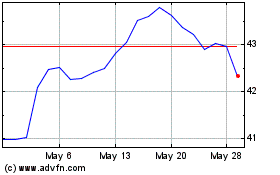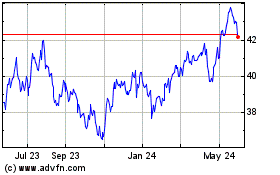As the ETF world has expanded in recent years, there has been a
race to the bottom so to speak, in terms of ETF expenses. Many
firms have slashed costs in order to be the cheapest ETF in a
particular category, hopefully giving their funds a decided
advantage over the competition.
While it may take quite some time, this trend towards lower
expense ratios by investors has often been the case in the ETF
world across a variety of products. Seemingly with nearly identical
funds that have solid trading volumes, new investors have done the
right thing for their own accounts and have gravitated towards the
lower cost funds (read Five Cheaper ETFs You Probably
Overlooked).
A great example of this can be seen in the emerging market ETF
world with the two MSCI Emerging Market Index following
juggernauts, VWO and EEM. For quite some time, EEM was by far the
largest in the emerging market ETF category, crushing all other
funds in terms of AUM.
However, this has changed in recent years, largely thanks to the
expense differential between the Vanguard fund (VWO), and iShares’
version (EEM). Currently, both funds track the exact same index but
EEM charges 67 basis points a year in fees while VWO costs just a
fraction of that at 20 basis points annually.
Largely due to this differential, as well as the fact that both
funds track the same index, investors have made VWO their ETF of
choice for the emerging market space. In fact, according to XTF.com
data, over the past three years VWO has seen $42 billion in inflows
while EEM has seen just $220 million in new dollars, a seismic
shift in the emerging market ETF landscape.
However, this isn’t the only time that iShares loses out to its
competitors on a cost front by any stretch of the imagination.
Instead, iShares is often lagging behind its smaller competitors
like Vanguard, Charles Schwab, or State Street in a number of
important ETF categories across a number of asset classes.
For example, in the large cap space, Vanguard leads the way with
the cheapest fund over iShares and their IVV, while the cheapest
sector ETFs are often dominated by the SPDR lineup from a cost
perspective (also see Banking ETFs 101).
Meanwhile the trend is no better in other asset classes besides
equities as PIMCO and Schwab easily beat out the iShares product
line on a cost front in the bond market, while the trend is
especially apparent in the real estate ETF segment with Vanguard
crushing the competition.
This trend, as well as the steady asset move away from high cost
funds to cheaper ones that have largely the same focus, has put the
pressure on iShares to become more cost competitive at least
according to some analysts in the space. However, while iShares is
taking some steps to rectify this in a number of segments, there
are a few categories in which it is the market leader.
Below, we highlight a few of these categories and the cheap
iShares ETFs that are contained within them. While this isn’t meant
to be an endorsement of these iShares products over the others in
the space, it should at least prove to some investors that iShares
is by no means ‘the expensive’ ETF issuer across the board.
Instead it should show that the San Francisco-based firm is just
as capable of beating its competitors on cost as the much vaunted
iShares, State Street, or newcomer Schwab often are for their
respective products. In light of this, we have highlighted five
cases in which iShares, despite its reputation as a high-cost ETF
issuer, is actually the cheapest option in the space:
Russia ETFs
In the Russia ETF world there are currently four unleveraged
choices available to investors. Currently, the Market
Vectors Russia ETF (RSX) leads the way in terms of total
AUM coming in at $1.7 billion in assets.
However, the fund is actually in the middle of the road when it
comes to expenses, charging investors 62 basis points a year in
fees. Meanwhile, iShares has the MSCI Russia Capped Index
Fund (ERUS) as a relatively new and cheaper competitor
(read Is Now The Time To Buy Russia ETFs?).
This product charges investors 58 basis points a year in fees,
just edging out RSX and State Street’s RBL for title of ‘cheapest
Russia ETF’. However, ERUS has just $150 million in assets, a
respectable figure, but nowhere near what RSX has amassed since its
inception.
India ETFs
The Indian economy is quickly growing and so is the ETF market
tracking the country. While just a few funds were initially
tracking the nation, there are now 10 products tracking India
without leverage.
Easily the most popular is the WisdomTree India Earnings
Fund (EPI) which has about $1 billion in assets, although
hit does charge investors 83 basis points a year in fees. This
figure also represents the middle of the road for the category, as
there are a few in the high 80s and one in the low 90s for
expenses, including iShares’ INDY at 0.91% (read India ETFs:
Getting Back on Track?).
Still, iShares also dominates the low expense side of the curve
with two of the cheapest funds in the space. By far the least
expensive is the iShares MSCI India Index Fund
(INDA) which costs investors a paltry 65 basis points in
comparison.
This crushes the market leader by 18 basis points, and is nine
basis points cheaper than the next fund on the list. Still the
product is relatively new, having debuted in February of this year,
so it has not attracted a significant following. However, it does
demonstrate that iShares is beginning to shift towards the low cost
model, at least in some of its newer country specific ETFs.
Gold ETFs
The gold market also represents a location in which iShares is
the cheapest choice. This is important as gold ETF investing has
really surged among many over the past few years, especially as
gold bullion has run up in price. In fact, there was a short time
in which there were more assets under management in the top gold
ETF than there were in SPY.
Although this is no longer the case, gold remains an important
ETF category for a least a few issuers. This is especially the case
for State Street and their impressive GLD. This fund is not only
one of the most well-known ETFs in the world, but is also one of
the more popular, having amassed nearly $70 billion in assets at
time of writing (read Shine & Protect Your Portfolio with Gold
ETFs).
However, the fund is somewhat expensive costing 40 basis points
a year in fees. This contrasts to a slightly cheaper choice from
ETFS with SGOL and the rock-bottom expense ratio from iShares and
their IAU.
IAU, much like GLD, tracks the price of gold bullion and trades
in truly impressive amounts that result in penny wide bid/ask
spreads. However, the fund is still overlooked in favor of the more
well known GLD, despite this cost differential.
There is some hope that this may finally be reversing, but
investors are still piling into GLD over IAU for many portfolios.
Nevertheless, IAU does represent one of the best strikes that
iShares has made to be the low cost competitor in a particularly
popular ETF category in which it doesn’t have the first mover
advantage.
Let us also not forget that $10 billion under management is
nothing to sneeze at, and the low cost has also probably helped the
fund to block other smaller competitors in the space as well,
suggesting that iShares’ strategy in this product may be better
than what we think.
China ETFs
China has been an extremely popular market for quite some time
thanks to its high growth rate, huge population, and incredible
rise over the past few decades. For at least a few years, investors
regarded the iShares FTSE China 25 Index Fund (FXI) as the only
real way to play the nation, as evidenced by the nearly $4.3
billion in total assets.
However, the fund is extremely concentrated and is somewhat
expensive, charging investors 72 basis points a year in fees. While
this didn’t matter when there was just a handful of other China
funds on the market, there are now roughly 18 products tracking the
nation, giving investors a great deal of choices in the country
(see Three China ETFs Still Going Strong).
To rectify this, iShares launched the MSCI China Index Fund
(MCHI) in 2011 as a low cost alternative in the space. The fund has
definitely caught on—having amassed about $350 million—while also
just edging out the more popular GXC from State Street for the
cheapest fund targeting the People’s Republic.
Broad Latin America ETFs
For targeting the broad Latin America region, there aren’t
exactly a lot of choices. In fact, there are just half a dozen in
total (if you are willing to count AND as well) while less than $2
billion is in the space.
Still, iShares dominates having the two cheapest funds in the
space including the behemoth of the segment ILF. This fund charges
50 basis points a year in fees and with another iShares fund, EEML,
they take up both the top spots for cheapest ETFs.
It is also worth noting that ILF besides being one of the
cheaper options, is also the biggest by far, making up roughly 91%
of assets in the broad Latin America market. Clearly, the
combination of the first mover advantage as well as the ultra-cheap
expense ratio has been a winning combination for iShares in this
category over the years (read Forget Argentina, Buy These Latin
America ETFs Instead).
Perhaps given the success of some of the funds listed above, and
iShares clear desire to stave off competition from low cost
competitors, the firm will reduce the expense ratios on some of
their more ‘expensive’ funds in the near future.
After all, it is pretty clear that investors prefer cheaper
products, no matter who the issuer is, suggesting that if iShares
wants to maintain its dominant lead in the space it will have to
shed its ‘high-cost’ label and embrace low cost ETF investing, much
like it has done in the above listed five categories.
Want the latest recommendations from Zacks Investment Research?
Today, you can download 7 Best Stocks for the Next 30
Days. Click to get this free report >>
Follow @Eric Dutram on Twitter
author is long VWO and IAU.
ISHARS-EMG MKT (EEM): ETF Research Reports
ISHARS-MS EM LA (EEML): ETF Research Reports
ISHARS-MS RUSSA (ERUS): ETF Research Reports
ISHARS-GOLD TR (IAU): ETF Research Reports
ISHARS-M INDIA (INDA): ETF Research Reports
To read this article on Zacks.com click here.
Zacks Investment Research
Want the latest recommendations from Zacks Investment Research?
Today, you can download 7 Best Stocks for the Next 30 Days. Click
to get this free report
iShares MSCI Emerging Ma... (AMEX:EEM)
Historical Stock Chart
From Dec 2024 to Jan 2025

iShares MSCI Emerging Ma... (AMEX:EEM)
Historical Stock Chart
From Jan 2024 to Jan 2025
